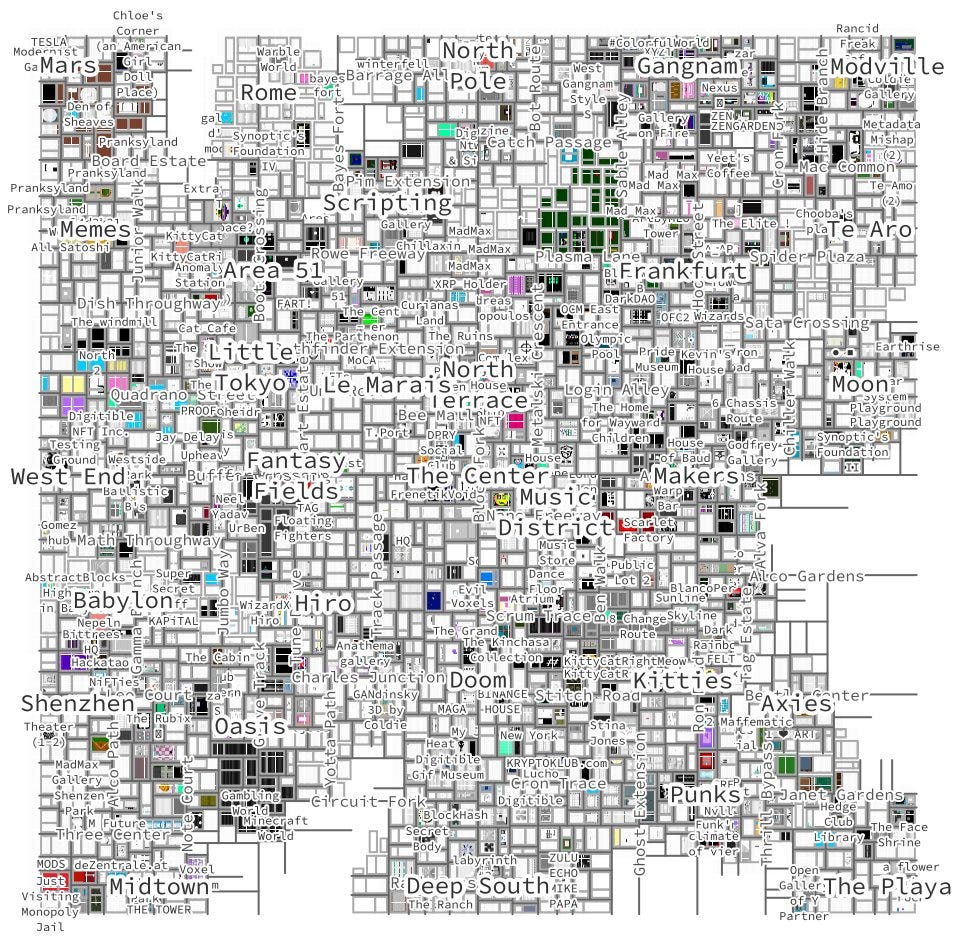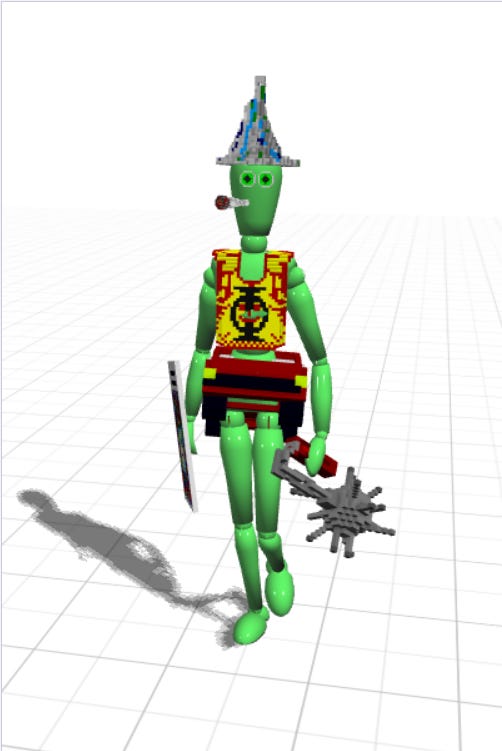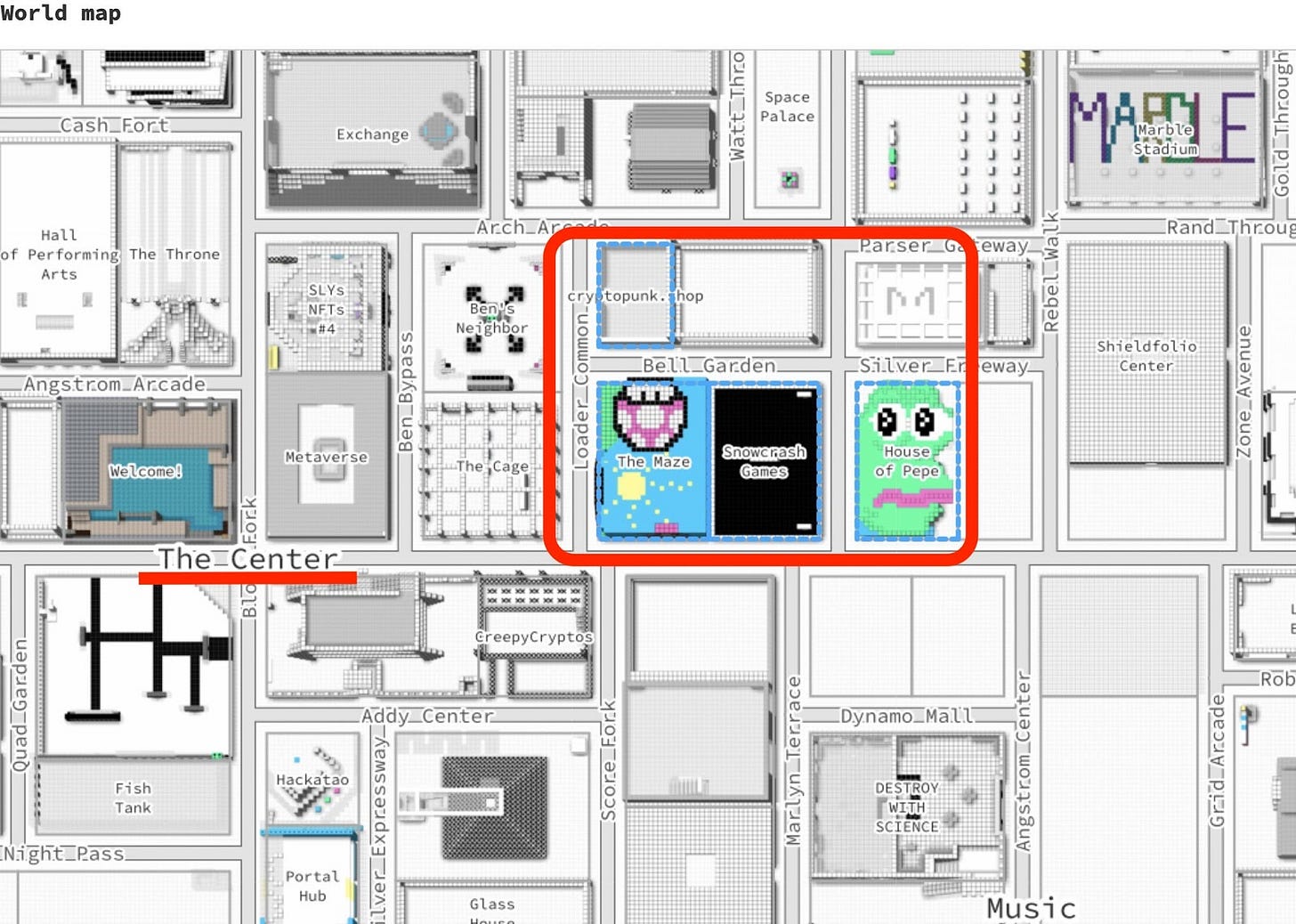🛠📈💸Cryptovoxels Investment Thoughts

This is not investment advice. This is the personal opinion of Andrew Steinwold.
TLDR
Cryptovoxels will become a dominant Ethereum-based virtual world. The founder built Cryptovoxels with a capital-light approach and it has grown organically: a prudent method in a market as nascent as the NFT market. Cryptovoxels has already found product-market fit within the cryptoart community, a community that will likely become incredibly large since cryptoart may be the next period in art history. If the Cryptovoxels team continues to execute as they have been, we could see Cryptovoxels reach valuations equal to, or even exceeding, Decentraland, the largest Ethereum-based virtual world.
I published a blog post in June 2019 outlining why I thought Cryptovoxels was exciting. At the time, I wrote a small section about whether or not Cryptovoxels represented a potential investment opportunity. I compared Cryptovoxel parcels to the Binance BNB token, which had a 30,000% increase. Clearly, it’s safe to say I was (and still am) bullish. I want to share my, more detailed, thoughts surrounding Cryptovoxels.
What Is Cryptovoxels?
Cryptovoxels (CV) is a blockchain-based virtual world platform. It is an open sandbox type environment where there are no objectives and users are free to do and build anything they want. Check out their website here.
Initial Approach
Ben Nolan, Cryptovoxels Founder, took the best approach to tackling such a project. Building an open Ethereum-based virtual world is an extremely esoteric project. Before CV launched, the only similar project that existed was Decentraland, which ultimately inspired CV’s creation. Ben Nolan worked for Decentraland for a period of time and, I assume, saw first hand what it got right, and wrong, and applied those lessons to launching CV.
The first, and perhaps most, important thing Ben did when launching CV was to not quit his day job. He worked on CV part-time because he recognized that such a new and risky project required him to stay lightweight and not acquire massive overhead costs. He received many offers to raise capital, but he rejected them to maintain creative freedom. Instead, he took a grassroots approach which has obviously paid off. He retains complete ownership of the project and can make all executive decisions. Instead of hiring a huge team or getting an office, he worked after his day job from his home and his van (lovingly known as the Cryptovoxels van). His funding model was genius since it grew as the platform grew. There are a capped number of parcels within CV (Origin City has a total 3,026) and every few weeks or so he sold some. These sales started out quite slow and cheap. The newly released parcels often did not even sell out but as more users joined the platform they began to sell out each time they were put on the market. As the user population grew and the demand for parcels increased, Ben increased the base price of the parcels which increased the amount he raised. Importantly, he only increased the price of parcels as the population grew so as not to price people out or set an arbitrarily high price. Now, from these parcel sales, he has roughly +2 years of runway.
It wasn't until roughly one year after launching CV that Ben quit his day job and focused on CV full-time. In the second half of 2019, Ben got an office in his home of Auckland, New Zealand but still kept the overhead low. In terms of employees, other people helped Ben occasionally, but it wasn’t until January 2020 when Ben hired his first full-time employee, Marcus. This is unique compared to the typical approach taken to launch a software product. People often choose to raise money on the idea alone and then proceed to get an office and hire employees.
However, hands down the most surprising thing that Ben did was not raise outside capital. There were numerous offers, ranging from individuals to venture capital firms, to discuss investments, but Ben committed to self-fund in order to maintain creative freedom and not lose the ability to grow and monetize as he pleased. As an example, venture capital firms would likely encourage Ben to monetize CV and require users to pay a monthly fee to access the platform. Luckily, he stuck to his slow and steady approach and, while still extremely early, it seems to be paying off.
Today
Let's dive into the factors that make Cryptovoxels successful today.
Product-market fit
Defacto place for NFT artists
Social space
Ease-of-use
Ease-to-build
Monetization
Product-market Fit
Product-market fit is defined as having a product that can satisfy a specific and substantial demand within a market. Cryptovoxels has discovered product-market fit within the fast-growing crypto/NFT market as an increasing number of users are seeking a hub to display their NFTs. Ingrained into human DNA is a desire to collect for a number of reasons, like:
Status signaling
Enjoyment
Utility
Investment
Taking into account the above reasons, wouldn't it be convenient and beneficial to display collected NFTs in a virtual world? Consider the following:
If you are driven by seeking status, others can marvel at your large collection of CV parcels.
If you enjoy collecting, you can display your beautiful NFT collections inside CV.
If you collect for utility, you can be ultra-creative and build anything you want, thus utilizing your CV parcel.
As for collecting for investment purposes, it's helpful to have an asset on display so someone can offer to buy it from you.
On this fundamental level, CV serves the entire NFT ecosystem on a single platform.
Defacto place for NFT artists
The crypto-art community is an NFT community that has already strongly adopted CV. As a crypto-artist, what place could possibly be better for you to showcase your work? Building in CV is intuitive, so creating a gallery and placing your art NFTs in said gallery is easy. Within an hour a user can build a simple gallery to serve as a digital venue for crypto-native folks to directly purchase art. This crypto-art network effect will be extremely strong to break because as more artists flock to CV it will bring more buyers, and liquidity begets liquidity. Also, these crypto-artists serve as a viral growth machine. They will often build beautiful galleries in-world and showcase them on social media. Fans of their artwork will see these amazing galleries on social media and want to join the platform. As more users enter, they begin to socialize and an entirely different dynamic takes place.
Social Space
CV is also acting as a social space: a 3D Facebook if you will. Instead of everyone having a profile page, users have parcels and can put anything on them. There are also meetups happening in-world. The Gangam Art Club, formed by Conlan, is a meetup group with people from all over the world that regularly meet to discuss all things cryptoart. Meetups are an incredible use case that could expand into numerous verticals. There has even been chatter about hosting in-world presentations soon. As the population grows, I could see users from various NFT projects having meetups to chat about their specific NFTs: Axie owners can meet in the Axies neighborhood, Cryptokitty owners could meet in the Cryptokitty neighborhood, and so on. There will always be innovation as users constantly discover new ways to use CV as a social platform.
Ease-of-Use
Cryptovoxels has multi-platform accessibility. In the past, video games were siloed to single platforms. For example, in my youth, I was not able to play Call Of Duty with my friends that had a PS3 since I had an Xbox 360. Only in the past couple of years have games started to be released on every possible platform: PC, Xbox, Playstation, smartphone, the more the merrier. This multi-platform accessibility has led to an explosion of game uses. Games with hundreds of millions of users, like Fortnite, Minecraft, and Rocket League, allow multi-platform use and greatly contribute to their success. CV is accessible via a web browser, virtual reality device, and even smartphones. This type of accessibility is hugely advantageous for a platform that is just taking off. Web and smartphone access especially opens up the doors to a large portion of the world's population. Users simply go to the website, click “enter world,” and you are there.
Ease-to-Build
Building things in the world is extremely easy. In December 2017, Minecraft hit 74m monthly active users. This is attributable to a number of factors, but multi-platform availability and how easy it is to build things are primary. Just as anyone can enter Minecraft and start building, anyone can do the same in CV. Creating incredible creations like the ones below require great skill, however, most users can quickly create simple structures.

(Devil, Artist and Metaverse Architect)

(Alotta Money, Artist and Metaverse Architect)
Allowing users to quickly start building in the platform is a huge advantage compared to platforms where the barriers to build are exceptionally high, such as 3D modeling skills or coding skills.
Monetization
The stickiest platforms/games tend to allow users to monetize in some form. Minecraft allows users to host their own servers, and as server owners, they can sell digital items or memberships. Roblox takes this a step further by allowing anyone to build entire games on their platform and monetize however they’d like. Luckily, since Cryptovoxels was built to be extremely open and plugged into the global financial infrastructure that is Ethereum, it natively allows users to monetize their in-game assets. I have already touched upon crypto-artists being able to directly sell their NFT artwork in-world, but there are also other methods in which users can monetize. The first iteration of monetization, which came from the CV team, are avatar outfits called wearables

(Cryptovoxels user MJMoonbow)
Anyone can make wearables and sell them on an open market. We are also seeing users rent parcels from other players. An interesting model developed by the CV user Conlan, is to purchase a group of adjacent parcels and develop them into one cohesive theme, just as a property developer would. The neighborhood where he built up his adjacent parcels, called Gangnam, became immensely popular and land values increased. In fact, it became so popular that users started to rent Gangnam parcels, yet another monetization method.
It is still extremely early for monetization on the Cryptovoxels platform, but as it evolves we will continue to see different monetization experiments. One interesting method will be games on the CV platform.
Soon
Games Within Games
I believe that implementing mini-games into parcel builds will be the next evolution for CV. Once users are able to play numerous games in-world, the functionality of Cryptovoxels increases by many orders of magnitude. I imagine these games will be quite simple at first but overtime, as more are built, will advance in terms of complexity. There has been chatter about creating a simple first-world shooter by enabling users to shoot blocks and also talks about creating simple casino-style games. If Decentraland can act as any sort of guide to what is possible, then this clip from this clip from Bence Varga should showcase what could come.


To explain further, this entire, seemingly large, game is happening on a few parcels of LAND within the Decentraland metaverse. If my understanding is correct, Bence Varga has created a type of game engine that gives the user the perspective of moving around a vast world, but the actual “physical” space of the game can be much smaller. If this type of technology can be ported into Cryptovoxels, then there are few limits on the types of games that could be hosted in-world.
Tomorrow
What could the future look like for Cryptovoxels? As the saying goes, “software is eating the world,” and that includes our physical one. It seems every day more people are living, working, and playing in fully virtual environments. Many people can do their jobs solely from the comfort of their homes with just a computer. Simply an internet-connected device can deliver daily entertainment, such as streaming shows, listening to podcasts, or playing games. These broader macro trends, like the rise of remote work and the societal acceptance of gaming, are perfectly positioning platforms like CV to gain immense value over the coming years. In my opinion, these platforms represent the very first iterations of the metaverse.
Metaverse 1.0
I believe that the missing ingredient for a true metaverse was the blockchain. A blockchain like Ethereum allows for digital scarcity and true digital asset ownership. True ownership of assets instills confidence in users to invest more time, money, and effort into their interactions with virtual economies and environments. On top of that, it also allows the developers and users to be instantly plugged into the pre-built, global financial system that is Ethereum. Because of these benefits, users and developers will invest more time and money to create larger and more robust virtual economies that are one of a kind. This is the dawn of a true version 1.0 metaverse. I disagree with the idea that true metaverses can exist with non-blockchain based assets, but that’s an argument for another day. Now that I have thoroughly explained all the reasons why I am bullish on Crytovoxels, I would like to dive into the reasoning behind why I purchased specific Cryptovoxels parcels.
Personal Position
Obviously, I am long Cryptovoxels. Over the past year I’ve been slowly acquiring a large position within the world. I have not sold a single parcel yet because I believe in the long-term vision for not only non-fungible tokens, but also the vision of a metaverse. Cryptovoxels seems extremely well positioned in both the NFT market and the market for an open metaverse.
When I first started investing in CV, I believed that height was a valued parameter for parcels. Thus, I acquired a large group of twelve adjacent parcels in Frankfurt, the neighborhood with the tallest height limit.

At the time of purchase, nobody had paid over 1 ETH for a single parcel bought directly from Ben (the lead developer). I remember causing a bit of a ruckus when bidding so much for the land, but I knew that if my thesis was even remotely correct then the 1 ETH price would be an incredible entry price. Recent (Jan/Feb 2020) individual parcel sales in the Frankfurt neighborhood have gone for between 30 and 200 ETH.
(30 ETH - Both 10 and 8 Elite Throughway each sold for 30 ETH)
(200 ETH - 2 Cash Road was part of the 500 ETH Playa bundle, but individually had a price of 200 ETH)
This parcel bundle is now potentially the most valuable group of parcels in Cryptovoxels because they contain the highest number adjacent parcels with some of the tallest build heights (9 of the 12 adjacent parcels have 18+ build height). There are taller parcels than these, but they are owned by multiple different owners, thus are not adjacent.
I also believed that The Center neighborhood would become extremely valuable due to all new entrants entering the world at “The Center” (underlined in red on the below map).

It was much more difficult to acquire these parcels as they had already been sold to other users and I needed to acquire them on the secondary market. For that reason, I was only able to acquire four adjacent parcels, but three of them happen to be on the main road that new users spawn into. In the future, these areas should have high numbers of foot traffic. I spent somewhere between 1-2.5 ETH each on these four parcels. Recent (Jan/Feb 2020) sales of individual parcels in The Center neighborhood have ranged from 29.5 ETH to 35 ETH.
(29.5 ETH - 4 and 6 Buffer Crossing recently sold for 29.5 ETH each)
(35 ETH - 1 Score Fork recently sold for 35 ETH)
Months after acquiring these parcels, I decided to do a comparable analysis in an attempt to value CV parcels (read my CV valuation blog post here). My hunch proved to be correct. Parcels with high height limits and in The Center neighborhood were valued at a premium.
Plans For Personal Position
To truly enact the vision of a metaverse, I intend on creating businesses or experiences on CV parcels. My goal is to have revenue-generating businesses within the metaverse within the next three years. To clarify, when I say metaverse it could be any blockchain-based virtual world, including CV, Decentraland, The Sandbox, Somnium Space, etc. The end goal is the metaverse, so the platforms that we use to get there do not matter. I have a strong feeling they will all end up melding together, much like how the early walled-off intranet became interconnected into the globally connected internet of today. I also want to point out that when I say “revenue-generating” business within the metaverse, I mean any sort of game or activity that brings in any amount of money in a sustainable fashion. If the businesses can bring in a steady $100 per month, I would consider that a huge win because that means a native, stable business is functioning in an entirely virtual economy.
Market Activity
As of writing this (Feb 2020), market activity has exploded as there recently have been numerous high sales. The monthly volume in early 2020 reached an astonishing $378k USD.

(Cryptovoxels monthly sales history, recorded Feb 14th, 2020 from nonfungible.com)
There has also been a flurry of high-value purchases. A few recent notable (early 2020) public sales include:
29.5 ETH ($5,500 at time of sale)
29.5 ETH ($5,500 at time of sale)
30 ETH ($6,400 at time of sale)
30 ETH ($6,400 at time of sale)
35 ETH ($7,500 at time of sale)
50 ETH ($10,000 at time of sale)
52 ETH ($8,500 at time of sale)
119 ETH ($25,000 at time of sale)
500 ETH ($110,000 at time of sale)
What Needs To Happen?
In order for tomorrow's future to play out, many, many things must go right. The CV team needs to continue to execute and grow as the broader NFT market grows. The number of users needs to massively increase from its current ~460. I hope that new users are not priced out of parcels and more areas outside of Origin City are minted. CV needs to continue to be a hub for all types of NFT collectors and gamers. The users of these different games and collections need a space to meet, hang out, and show off their assets. It would be amazing to host Gods Unchained tournaments within CV, or be able to walk around with Axies and battle them in real-time. CV needs to especially continue to be the number one location for NFT art. NFT art will grow into an absolutely massive industry that will one day rival the traditional art space, so continuing to encourage artists to build in CV is a must. If all of these things happen, Cryptovoxels stands a very good chance on being a thriving piece of the future metaverse, but with that said, we should keep in mind that we are not even in the first inning for NFT-enabled metaverses. Decentraland only has ~3,500 users and Cryptovoxels only has ~460. We are still extremely early and much more needs to happen, but the technology and timing seem right for a true metaverse to form.

If you liked this content please subscribe to my newsletter, Zima Red,
and give me a follow on Twitter. Stay tuned for more articles on unique digital assets and all things virtual. 😎
